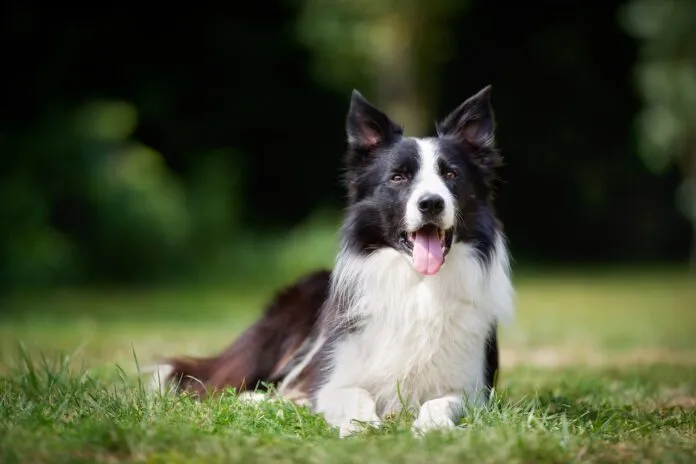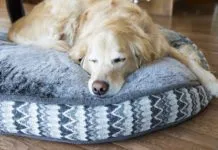A dog with a double coat essentially has two types of hair: a smoother, protective topcoat and a dense, rough undercoat. Double-coated dog breeds come in all shapes, sizes, and temperaments. There are too many to list all of them, but some of the most popular double-coated dogs include Corgis, Border Collies, Golden Retrievers, German Shepherds, and Bernese Mountain Dogs. Regardless of shape and size, one thing they all have in common is shedding.
“Anyone considering getting a double-coated breed should know that there is no one solution to stop shedding,” says Joy Burton, AKC-certified professional dog groomer and co-owner of a Well Groomed franchise location in California. “The shedding is going to happen year-round so prepare yourself by getting all the necessary grooming tools you will need to maintain their coat at home as well as keeping them on a consistent grooming schedule to prevent undercoat buildup and excess shedding.”
Grooming Double-Coated Dogs
Regular grooming is an important part of caring for a double-coated dog. Without a proper grooming routine, the dog’s fur can form tangles and mats that may need to be cut out. If left unattended for long enough, these can become painful and even cause sores or skin damage.
Part of developing a good grooming strategy for your dog is understanding how his coat works. “The topcoat helps repel moisture and dirt while the undercoat works like insulation, protecting the pet from both cold and hot temperatures,” Burton says. “Double coats vary amongst breeds.”
To keep both layers of a double coat in good shape, you’ll want to:
- Brush your dog three to four times a week to prevent undercoat buildup—and even more so during high-shedding seasons like summer and winter.
- Use a rubber brush paired with a short bristle slicker brush on short, double coats.
- Use a medium to long bristle slicker brush, greyhound comb, and undercoat rake on medium- and long-haired double coats.
- Use a line-brushing technique to catch mats or dead undercoat. To “line-brush” a dog:
- Use a brush or comb to separate out a small section of fur.
- Mist the section with water or a detangling product (be sure to follow the directions on the label).
- Brush the section thoroughly with a pin brush.
- Run a comb through the section to ensure there are no tangles hiding.
- Move on to a spot a little above or to the side of the first section and repeat the process until the whole dog has been brushed out. It works best to start low and work your way up.
- Get a deshedding bath at the dog’s regular grooming appointment every four to eight weeks.
- Unless necessary for medical reasons, never shave a double-coated dog. “Doing so will permanently damage their coat,” Burton says. “It will grow back rough and patchy, dry or very oily, and could even not grow back at all. It also strips away the dog’s ability to cool themselves down in warmer weather and keep themselves warm in colder weather. The grow-back process after a double coat is shaved down can be very irritating and uncomfortable for them.”
Should You Get a Double-Coated Dog?
Many dog breeds have double coats and double coats themselves vary in length, thickness, and care required, so there are a lot of options for people interested in a double-coated dog. If you are thinking about bringing a double-coated dog into the family, the biggest thing to consider when it comes to the coat type is whether you mind shedding and some grooming maintenance.
“I would recommend double-coated breeds to anyone who can commit to the grooming maintenance that is required for this coat type,” says Joy. “I would also recommend them to anyone who lives in a cooler climate. Breeds like Siberian Huskies and Newfoundlands thrive in cooler environments.”
5 Popular Double-Coated Dog Breeds
While there are many double-coated dog breeds out there, here are a few popular examples:
- Active and intelligent, Pembroke Welsh Corgis are smaller, roughly 30-pound herding dogs with thick, short double coats that shed significantly.
- Border Collies often top lists of most intelligent dogs with double coats that come in both short and medium lengths. These medium-sized herders are incredibly active and agile working dogs that usually do best in active families.
- Golden Retrievers are medium-large hunting dogs with a long list of job titles—from family pet to guide dog. Their medium-length double coats come in variations of gold. Known for their generally friendly temperaments, they are also energetic and need regular exercise.
- German Shepherds have double coats that come in a variety of lengths and colors. Though technically herders, they’re all-around hard workers, sometimes finding jobs in law enforcement. They’re typically intelligent, protective, and loyal to their families, but do need plenty of exercise and often prefer to have a job.
- Bernese Mountain Dogs are a larger working breed with a long, thick double coat. They frequently have a more relaxed disposition and, although they are workers, their exercise requirements tend to be more on the moderate side.









THX!!!